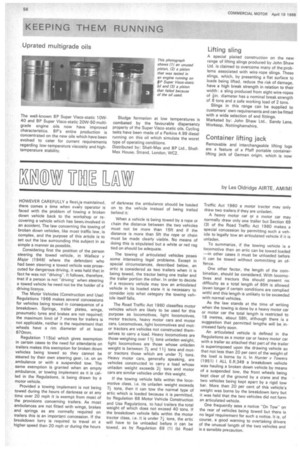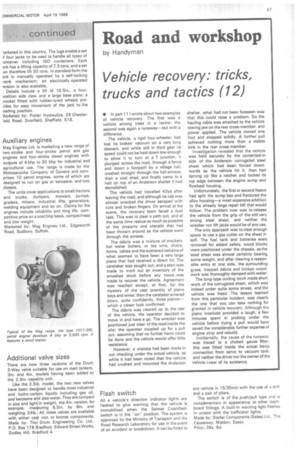EROM 71111 by Les Oldridge AIRTE, AMIMI
Page 58

Page 59

If you've noticed an error in this article please click here to report it so we can fix it.
HOWEVER CAREFULLY a fleets maintained, there comes a time when every operator is faced with the problem of towing a broken down vehicle back to the workshop or recovering a vehicle which has been, involved in an accident. The law concerning the towing of broken down vehicles, like most traffic law, is complex, and the purpose of this article is to set out the law surrounding this subject in as simple a manner as possible.
Considering first the position of the person steering the towed vehicle, in Wallace v Major (1946) where the defendant who had been steering a towed vehicle was prosecuted for dangerous driving, it was held that in fact he was not "driving". It follows, therefore, that if a person is not "drivingwhen steering a towed vehicle he need not be the holder of a driving licence.
The Motor Vehicles (Construction and Use) Regulations 1966 makes several concessions for vehicles being towed in consequence of a breakdown. Springs, trailer plates, wings, pneumatic tyres and brakes are not required; the maximum limit of 7 metres for trailers is not applicable, neither is the requirement that wheels have a rim diameter of at least 670mm.
Regulation 115(a) which gives exemption in certain cases to the need for attendants on trailers makes this exemption for broken down vehicles being towed so they cannot be steered by their own steering gear, i.e. on an ambulance or with a suspended tow. The same exemption is granted when an empty ambulance, or towing implement as it is called in the Regulations, is being drawn by a motor vehicle.
Provided a towing implement is not being towed during the hours of darkness or at any time over 20 mph it is exempt from most of the provisions concerning trailers. As most ambulances are not fitted with wings, brakes and springs as are normally required on trailers this is an important concession. If the breakdown lorry is required to travel at a higher speed than 20 mph or during the hours of darkness the ambulance should be loaded on to the vehicle instead of being trailed behind it.
When a vehicle is being towed by a rope or chain the distance between the two vehicles must not be more than 15ft and if the distance is more than 5ft the rope or chain must be made clearly visible. No means of doing this is stipulated but a white or red rag tied on should be adequate.
The towing of articulated vehicles pose's some interesting legal problems. Except in special circumstances, described below, an artic is considered as two trailers when it is being towed, the tractor being one trailer and the trailer portion the other. In order to decide if a recovery vehicle may tow an articulated vehicle in its loaded state it is necessary to consider into what category the towing vehicle itself falls.
The Road Traffic Aot 1960 classifies motor vehicles which are likely to be used for this purpose as locomotives, light locomotives, motor tractors, heavy motor cars and motor cars. Locomotives, light locomotives and motor tractors are vehicles not constructed themselves to carry a load. Heavy locomotives are those weighing over 111 tons unladen weight, light locomotives are those whose unladen weight is between 71 and 111 tons and motor tractors those which are under 7,1 tons. Heavy motor cars, generally speaking, are vehicles constructed to carry a load whose unladen weight exceeds 21 tons and motor cars are similar vehicles under this weight.
If the towing vehicle falls within the locomotive class, i.e. its unladen weight exceeds 71 tons, then it can tow the normat type of artic which is loaded because it is permitted, by Regulation 68 Motor Vehicle Construction and Use Regulations, to haul trailers the total weight of which does not exceed 40 tons. If the breakdown vehicle falls within the motor tractor class, i.e. it is under 7-,1 tons, the artic will have to be unloaded before it can be towed, as by Regulation 69 (1) (b) Road Traffic Act 1960 a motor tractor may only draw two trailers if they are unladen.
A heavy motor car or a motor car may normally draw only one trailer but Section 69 (3) of the Road Traffic Act 1960 makes a special concession by permitting such a vehicle to legally tow an articulated vehicle if it is unladen.
To summarize, if the towing vehicle is a locomotive then an artic can be towed loaded —in other cases it must be unloaded before it can be towed without committing an of fence. '
One other factor, the length of the combination, should be considered. With locomotives and tractors this should present no difficulty as a total length of 85ft is allowed (even longer if certain conditions are complied with) and this length is unlikely to be exceeded with normal vehicles.
As the law stands at the time of writing when the towing is done by a heavy motor car or motor car the total length is restricted to 18 metres, about 59ft, although there is a suggestion that permitted lengths will be increased fairly soon.
An articulated vehicle is defined in the Regulations as a motor car or heavy motor car with a trailer so attached that part of the trailer is superimposed upon the drawing vehicle so that not less than 20 per cent of the weight of the load is borne by it. In Hunter v Towers (1951) I ALL E.R.349 a breakdown vehicle was hauling a broken down vehicle by means of a suspended tow, the front wheels being kept clear of the ground by a crane and the two vehicles being kept apart by a rigid tow bar. More than 20 per cent of this vehicle's weight was borne by the breakdown lorry but it was held that the two vehicles did not form an articulated vehicle.
One frequently sees a notice "On Tow" on the rear of vehicles being towed but there is no legal requirement for such a notice. It is, of course, a good warning to overtaking drivers of the unusual length of the two vehicles and is a sensible precaution. larketed in this country. The lugs enable a set • f four jacks to be used to handle all types of ontainer including ISO containers. Each ck has a lifting capacity of 7.5 tons, and a set an therefore lift 30 tons. In standard form the ack is manually operated by a self-locking :rank mechanism: an electrically operated ■ ersion is also available.
Details include a lift of 19.5in., a four>osition side claw and a large base plate; a >racket fitted with rubber-tyred wheels protides for easy movement of the jack to the oading position.
VI a rketed by: Potter Hydraulics, 29 Chestertold Road, Dronfield, Sheffield, S18.
Auxiliary engines
Mag Engines Ltd. is marketing a new range of two-stroke and four-stroke petrol and gas engines and four-stroke diesel engines with outputs of 4 bhp to 30 bhp for industrial and agricultural use. The range is made by the Motosacoche Company of Geneva and comprises 10 petrol engines, some of which are designed to run on gas or kerosene, and two diesels.
The units cover applications to small tractors and trucks, dumpers, mowers, pumps, graders, mixers, industrial lifts, generators, welding equipment and so on. Claims for the engines include reliability and long life, competitive price on a cost/bhp basis, compactness and low weight.
Marketed by: Mag Engines Ltd., Edgeworth Road, Sudbury, Suffolk.
Additional valve sizes
There are now three versions of the Drum 3-Way valve suitable for use on road tankers, 3in. and 4in. models having been added to the 2.5in.-capacity unit.
Like the 2.5in. model, the two new valves have been designed to handle most industrial and hydro-carbon liquids including gas oil, and kerosene arid also water. They are compact in size and light in weight, the 4in. version, for example, measuring 6.5in. by 8in. and weighing 241b.1All three valves are available with either cast iron or bronze components. Made by: The Drum Engineering Co. Ltd., P.O. Box 178 radford, Edward Street Works, Dudley Hill, Bradford 4.
Flash switch
All a vehicle's direction indicator lights are flashed to give warning that the vehicle is immobilized when the Selmer Crashflash switch is in the "on" position. The system is approved by the Ministry of Transport and the Road Research Laboratory for use in the event of an accident or breakdown. It can be fitted to any vehicle in 15/30min with the use of a drill and a pair of pliers.
The switch is of. the push/pull type and is complementary in appearance to other dashboard fittings. A built-in warning light flashes in unison with the trafficator lights.
Made by: Stellar Components (Sales) Ltd.. The Causeway. Maldon. Essex.
Price: 39s. 6d.








































































































































